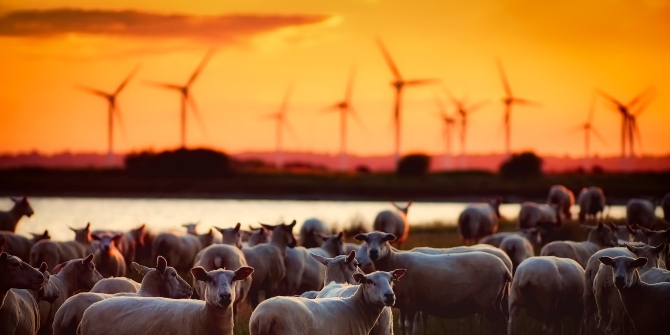
Throughout Europe, wind power has been growing rapidly, indeed it has achieved a quarter of total electricity production in Germany, for example. However, wind power generation has two problems- it fluctuates widely as the wind speed differs and it is often windiest in areas remote from the population. Because electricity supplied must always equal electricity demanded, the system operator needs to maintain a careful balance between what is flowing from generators through the pylons and demand. Given this context, significant growth in wind farm generation in remote parts of Scotland, poorly connected to more populous areas, has created a problem.
“Scottish wind farm paid £96M to switch off” is an example of a newspaper headline that particularly irks people who find wind turbines ugly, as well as being deeply puzzling to many. Why pay someone to switch off?
The Western Link is an undersea cable linking Scottish wind farms to England that aims to reduce or eliminate such problems. We ask: has it worked, and if not, why? Our research finds it has only been a very limited success. One of the problems is the behaviour of wind farms. Given this, additional controls would improve matters.
National Grid, seeing the problem of needing to tell wind farms not to produce, and faced with opposition to running pylons through swathes of Scottish and borders landscape, decided to build the Western Link, a subsea interconnector that does the job of moving this power to where it is needed. Unfortunately, it has been subject to several significant failures over the two years it has been in operation. The downside is that payments to Scottish wind farms to stop producing are higher when the link is not working. The upside for research is that, after controlling for other factors, we can evaluate how much the link saves in payments to Scottish wind farms when it is operating. The first pass answer our research suggests is around £45 million a year if it worked all the time. This is worth having, but pales beside the cost of the interconnector, said to be around £1.2 billion.
Why is it not saving more? Here we enter one of economists’ favourite areas, the role of incentives. A naïve view would be that when a wind farm can produce it will, because the wind is free. But this neglects the subtlety of the system, in which the incentive of a wind farm is to maximise its revenue. We show that wind farms offer to produce more relative to a forecast based on wind speeds when the price obtained is relatively high, when the penalty for failing to produce what was offered is relatively low, and when predictions of the price paid to a farm forced to switch off are high. In fact, the last of these — payments to persuade them to switch off — have been running at very high levels, and continue to do so, so that it can be more valuable to commit to produce, but be told not to, than actually to be paid for generating electricity.
Is this a purely domestic economy issue, due to the quirks of the British system? Arguably not. Britain is by no means alone in having a grid system based on the idea of bringing power from large power stations located alongside major rivers to populations and industry not far distant. Germany has found much the same problem in its rapid dash to install renewable energy from solar power as well as wind. Converting the system to a “new normal” of increased renewable power, for important reasons relating to climate change, reveals many problems in its wake. Increased interconnection is part of the answer, but reforming the payments made to operators is just as urgent. In doing this, clearly operators will optimise relative to the constraints of the system. Solutions need to bear this in mind.
♣♣♣
Notes:
- This blog post is based on Do British wind generators behave strategicallyin response to the Western Link interconnector?, Warwick Economic Working Paper 1242, presented at the European Economic Association’s Annual Congress, August 2020.
- The post expresses the views of its author(s), not the position of LSE Business Review or the London School of Economics.
- Featured image by 12019, under a Pixabay licence
- When you leave a comment, you’re agreeing to our Comment Policy
 Mario Intini is a researcher in industrial economics at the University of Bari, Italy.
Mario Intini is a researcher in industrial economics at the University of Bari, Italy.
 Michael Waterson is a professor in the department of economics at the University of Warwick.
Michael Waterson is a professor in the department of economics at the University of Warwick.






Since when did the industrial scale slaughter of Birds and Bats, by the million, become ‘clean green’ energy?
Every year in Spain alone — according to research by the conservation group SEO/Birdlife — between 6 and 18 million, yes million, birds and bats are killed by wind farms. They kill roughly twice as many bats as birds.
The Tasmanian Wedge-tailed Eagle is at the point of extinction due to wind farms. Recent research from around the world indicates horrific bird mortality rates:-
Spain – 330 Birds per turbine per year
Germany – 309 Birds per turbine per year
Sweden – 895 Birds per turbine per year
When will the wind industry be forced tell us the appalling truth?
And before the absurd is mentioned, I’ve never seen an eagle, gannet or fulmar killed by a cat, car windscreen, or kitchen window!
Scottish windfarms have been paid just under £773m. to date, mainly because they’re built in remote areas and, as the article says,due to the lack of connection. Yet they keep building them. The rest of the UK has only paid £62m. Makes no sense.